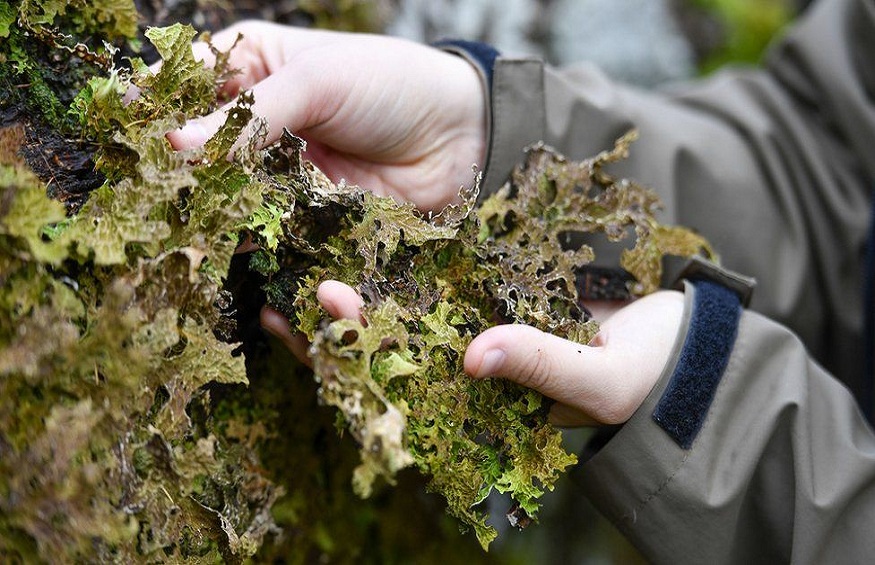Lichen, a seemingly inconspicuous organism, plays a fascinating yet often problematic role in the life of trees. These unique partnerships between fungi and algae can thrive on tree bark, branches, and trunks, creating a captivating mosaic of colors and textures. However, while they may appear harmless, lichen can impact tree health and vitality.
The harmonious coexistence of trees and lichen is a captivating sight in nature. Still, when lichen growth becomes excessive, it can interfere with a tree’s ability to photosynthesize and breathe, potentially leading to weakened trees and diminished overall forest health. In this regard, addressing lichen overgrowth is essential, but it’s equally important to do so without causing harm to the environment. That’s where the significance of natural removal methods comes into play. By opting for eco-friendly solutions, we protect the trees and safeguard the intricate web of life that relies on them.
Understanding Lichen
Lichen, an enigmatic fusion of algae and fungi, captivates nature enthusiasts and scientists with its remarkable symbiotic relationship. This fusion forms a unique organism that can thrive in various environments, including trees.
How Lichen Influences Trees
While seemingly innocuous, Lichen’s presence on trees holds implications for these arboreal giants’ health and well-being. Lichen can play a role in both benefiting and potentially harming trees. Understanding this dynamic interaction is essential for arborists, horticulturists, and nature enthusiasts keen on preserving the vitality of our forested landscapes.
Natural Methods for Removing Lichen from Trees
1. Pruning and Trimming
When dealing with lichen on trees, start by Pruning and Trimming. Regularly cutting away overgrown branches and twigs enhances the tree’s overall health and removes lichen habitat. This method helps increase airflow and sunlight exposure to the affected areas, making it less favorable for lichen to thrive.
2. Manual Removal
In Manual Removal, gently scrape off lichen with a soft brush or sponge. Avoid using abrasive materials that could harm the tree’s bark. This hands-on approach allows you to target specific areas and ensure the lichen doesn’t return. Remember to wear gloves to protect your hands during this process.
3. Promoting Beneficial Predators
Encouraging Beneficial Predators, like ladybugs and lacewings, can be a natural way to combat lichen. These insects feed on the tiny pests that often attract lichen. Creating an environment that welcomes these helpful creatures will indirectly reduce lichen growth without harmful chemicals.
4. Changing Environmental Conditions
Adjusting Environmental Conditions around your trees can deter lichen growth. Simple changes like improving drainage, reducing excessive moisture, or enhancing ventilation can make the environment less favorable for lichen. A balanced environment is vital to keeping lichen at bay.
5. Homemade Lichen Remedies
Consider using Homemade Lichen Remedies, such as a baking soda and water mixture or a diluted vinegar solution. These DIY concoctions can be applied to affected areas, disrupting lichen’s growth. Testing a small area first is essential to ensure your remedy doesn’t harm the tree’s bark.
Preventing Lichen Return
Proper Tree Care
Maintaining optimal tree health is fundamental in preventing lichen from making a comeback on your trees. Prune away dead or diseased branches, ensuring good air circulation and sunlight penetration. Adequate watering and mulching also help trees thrive, making them less susceptible to lichen infestations. Properly prioritizing tree care creates an environment less conducive to lichen growth.
Regular Inspection
Regularly inspecting your trees for lichen growth is a proactive approach to control its resurgence. Be looking for green, gray, or white patches on the bark. Early detection allows you to take action before lichen can establish a strong presence. Promptly remove lichen by gently scrubbing or spraying with water and mild detergent, ensuring it doesn’t get a foothold on your trees.
Sustainable Practices
Embrace sustainable landscaping practices to discourage lichen from returning. Planting diverse tree species in your yard can help disrupt lichen’s preferred host plants. Additionally, avoid over-fertilizing or using harsh chemicals in your garden, as these can inadvertently encourage lichen growth. Adopting sustainable gardening practices creates an ecosystem less inviting to lichen, promoting long-term tree health.
In conclusion, safeguarding trees from excessive lichen growth requires eco-friendly methods like pruning, manual removal, beneficial predators, environmental adjustments, and homemade remedies. Prioritizing proper tree care, regular inspection, and sustainable practices are vital to maintaining tree vitality and preventing lichen return.
Publisher’s Details:
Green Leaf Zone
23312 Park Mariposa, Calabasas, CA 91302
(866) 471-0369
greenleafzone.com
In exploring natural tree care methods, we must familiarize ourselves with essential tree care terminology. First Legal’s blog post is an excellent resource for deepening your understanding of tree maintenance. Additionally, for those seeking expert brush-clearing services in Los Angeles, CA, Green Leaf Zone stands out as a top choice, known for their exceptional services and commitment to tree health.
Read: Tree Care Terms 101: Important Words and Phrases You Should Know




